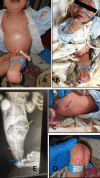Mermaid Syndrome: Navigating the Challenges of a Rare Congenital Disorder
- PMID: 39534800
- PMCID: PMC11554444
- DOI: 10.7759/cureus.71317
Mermaid Syndrome: Navigating the Challenges of a Rare Congenital Disorder
Abstract
Sirenomelia, or mermaid syndrome, is a rare congenital disorder characterized by the fusion of lower limbs and often associated with multisystem organ dysfunction, resulting in poor survival beyond the neonatal period. We report a case of sirenomelia in a full-term infant born to a 28-year-old primigravida with no significant medical history, gestational diabetes, or teratogenic exposure. The antenatal period was complicated by oligohydramnios, though routine ultrasounds failed to detect the condition. The diagnosis of sirenomelia was only made after delivery by cesarean section, with a compatible-with-life appearance, pulse, grimace, activity, and respiration (APGAR) score. The infant was referred to the pediatric surgical department due to abdominal distension and fused lower limbs, with plans to manage these conditions if the infant survived long-term. During the three-day hospital stay, vomiting was noted, and a babygram confirmed Stocker and Heifetz type IV sirenomelia and distended large bowel. An exploratory laparotomy revealed gross gastrointestinal and genitourinary abnormalities. A sigmoid colostomy was performed to relieve obstruction. Unfortunately, the infant expired shortly after surgery. This case highlights the challenges of prenatal diagnosis and the limited understanding of surgical management in sirenomelia, particularly given the rarity of survival beyond the neonatal period.
Keywords: congenital anomaly; mermaid syndrome; neonatal surgery; oligohydramnios; sirenomelia.
Copyright © 2024, Tanveer et al.
Conflict of interest statement
Human subjects: Consent was obtained or waived by all participants in this study. Conflicts of interest: In compliance with the ICMJE uniform disclosure form, all authors declare the following: Payment/services info: All authors have declared that no financial support was received from any organization for the submitted work. Financial relationships: All authors have declared that they have no financial relationships at present or within the previous three years with any organizations that might have an interest in the submitted work. Other relationships: All authors have declared that there are no other relationships or activities that could appear to have influenced the submitted work.
Figures


Similar articles
-
Sirenomelia or "Mermaid Syndrome" in a Twin Pregnancy: A Case Report.Cureus. 2023 Jan 28;15(1):e34311. doi: 10.7759/cureus.34311. eCollection 2023 Jan. Cureus. 2023. PMID: 36860221 Free PMC article.
-
Sirenomelia: The mermaid syndrome: Report of two cases.J Nat Sci Biol Med. 2015 Jan-Jun;6(1):264-6. doi: 10.4103/0976-9668.149227. J Nat Sci Biol Med. 2015. PMID: 25810681 Free PMC article.
-
Mermaid syndrome: A case report in Somalia.Ann Med Surg (Lond). 2022 Mar 29;76:103533. doi: 10.1016/j.amsu.2022.103533. eCollection 2022 Apr. Ann Med Surg (Lond). 2022. PMID: 35495377 Free PMC article.
-
Sirenomelia: a new type, showing VACTERL association with Thomas syndrome and a review of literature.Birth Defects Res A Clin Mol Teratol. 2013 Mar;97(3):123-32. doi: 10.1002/bdra.23125. Birth Defects Res A Clin Mol Teratol. 2013. PMID: 23526679 Review.
-
Sirenomelia in twin pregnancy: A case report and literature review.Medicine (Baltimore). 2018 Dec;97(51):e13672. doi: 10.1097/MD.0000000000013672. Medicine (Baltimore). 2018. PMID: 30572488 Free PMC article. Review.
References
-
- Sirenomelia: a case report with literature review. Sahu L, Singh S, Gandhi G, Agarwal K. Int J Reprod Contracept Obstet Gynecol. 2013;2:430–432.
-
- Sirenomelia: review of a rare syndrome with case report, review of anatomy, and thoughts on management. Pederson WC, Phillips WA, Jalalabadi F, White L, Reece E. Plast Reconstr Surg. 2022 Dec;150:1321–1331. - PubMed
Publication types
LinkOut - more resources
Full Text Sources
